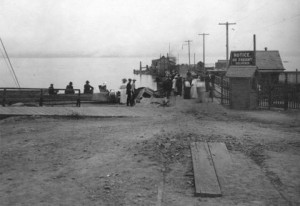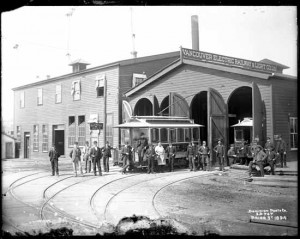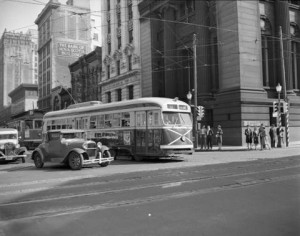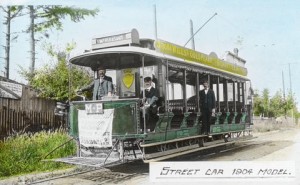Vancouver is a rapidly growing city with increasing demand for more efficient, more reliable public transit. Since the success of a temporary street car line during the 2010 Olympic Games, Vancouverites have been wondering about the possibility of bringing back the Vancouver street cars. Most recently this article caught our attention and we thought it would be interesting to take a look back at the evolution of Vancouver’s original public transit system, and try to imagine if it could be re-incorporated into the current system.

Beginning in 1897, the street car was king of Vancouver transportation. At its height in 1914, 232 BC Electric vehicles roamed the streets of our city. The dark green painted wooden two-man cars carried passengers to all corners, and the rail lines of the Interurban brought passengers to and from New West during the day and supplies from farms overnight. The system also included the No. 25 which trudged up North Vancouver’s notoriously steep-hilled Lonsdale Ave, with only a few incidents of cars rolling back down into the water, and West Vancouver’s Blue Bus, which is the oldest continuously operating bus company in North America.

BC Electric was a truly local company, building all its own cars out of a bus barn at Main and Prior, eventually upgrading to a larger facility at Main and 14th. The original wooden street cars were so expertly built that many ran through the entire life cycle of street cars in Vancouver, which amounts in some cases to 50+ years of service. Two of the most famous cars came from Montreal design plans which boasted an open air roof. The open-roofed cars became famous for conductor Teddy Lyons, well known for his terrible yet hilarious puns, who entertained passengers along the route. Passengers were also greeted with singing school children at stops and the opportunity to purchase a photo of their journey from photographer Harry Bullen.
The 1920’s would bring the beginning of big changes in transit. At midnight December 31st, 1922 master mechanic George Dickie switched the entire system from left-hand drive to the North American adoption of right hand driving, leaving many Vancouverites to wake up to a state of confusion. No accidents were recorded, but there wasn’t a lot documented about the overnight switch.

The 20’s also saw the creation of “The Buzzer” a small publication still found on transit vehicles today, and as a blog on Translink’s website. It originally held schedules, company updates, local events, and even a joke or two. The biggest change came when many of the cars were updated from all-wood two-man operated to fancier single-man operated steel vehicles with cushioned leather seats. The cars got a colour upgrade as well, trading in their forest green exterior to a new crème and red scheme.
The elaborate expansion came just before a decline in ridership caused by a combination of growing automobile popularity, the Depression, and then two world wars which forced the transit system into hard times. Faced with declining profits, an aging fleet of mostly wooden cars, and a growing city in need of efficient public transit, BC Electric made the decision to switch to trolley buses, an idea borrowed from Seattle. Expanding routes would be less expensive without having to lay rail, and the vehicles themselves were quieter and cheaper to run as they utilized the company’s ownership of electrical lines. The last streetcar rolled off Hastings Street to many tears on April 24, 1955 after 65 years of service.

So where do you stand, Vancouver? Are street cars just a quirky part of our history, or can they be successfully incorporated into our modern system?
For more about Vancouver’s street car history:
The Transit Museum Society
The Burnaby Museum has an original tram car on display
One of Vancouver’s best known ghost stories resides in the Tram at the Old Spaghetti Factory
For more on the modern street car debate:
Globe and Mail – February 2010
City of Vancouver’s Transportation 2040 Transit Plan
All images from the Vancouver Public Library Digital Archives. Research from The Greater Vancouver Book, Chuck Davis, 1997.

3 comments
BC Electric did in fact build a lot of its own equipment, but not at Main and Prior or Main and 14th. These were carbarns ( similar to a modern day bus garage) used for storage and general maintenance.
The shops were located at Stewardson Way and 12th in New Westminster. Key West Ford has buildings on almost the exact footprints of the BCER shop complex–in fact, if you look from the SkyTrain (going westbound) you will see a section of curved track embedded in asphalt pointing toward where the buildings once stood. The other major shop was the Kits Shops, located under the south end of the Burrard Bridge.
Both shops did major rebuilds, but the iconic Vancouver streetcars, known as the “Narragansett” type were built in New Westminster Nearly 100 of these were built, along with the less familiar “Fairview” type and various other designs used in Victoria and Vancouver.
Many of the larger interurban cars were also built by BCER in their own shops. Of a total production of hundreds of vehicles, only three BCER built vehicles exist today: Car 53, a four wheeled streetcar located inside the Spaghetti Factory on Water St., Interurban 1207, currently stored at the Downtown Historic Railway carbarn at False Creek, and Interurban 1304, undergoing restoration at the Fraser Valley Heritage Railway carbarn at Cloverdale.
Thanks, Peter, for the great additional information!
The only operating original BCER interurban today is BCER 1225. It operates on weekends only until Thanksgiving weekend.
BCER 1225 ended the rail service by the BC Electric Co. after it pulled into Marpole Station at 1:30 am on February 28th, 1958.
As 1225 operates on a working freight line on a portion of the old BCER Fraser Valley Line operations are subject to track availability. In order not to be disappointed Please check http://www.fvhrs.com as late as noon on a Friday to confirm operations or visit the FVHRS Facebook page. A link is provided on the web site. Directions and more on the history of the 1225 and the Society can also be found on the web page.
Enjoy part of the Lower Mainland’s transportation history come for a ride!